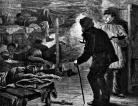The Moonstone
circa. 1868
In 1868, Tinsley Brothers published the first edition of The Moonstone by Wilkie Collins (1824-1889), which became known as the precursor of the modern mystery novel. Rachel Verinder, a young English woman, inherits a sacred Indian diamond from her corrupt, opium-addicted uncle who stole the gem from Brahmin priests while he served in the British East India Company. The cursed diamond introduces numerous forms of loss, dissolution, and death into the lives of the English characters.
Associated Places
No places have been associated with this eventby Adiam Woldu



